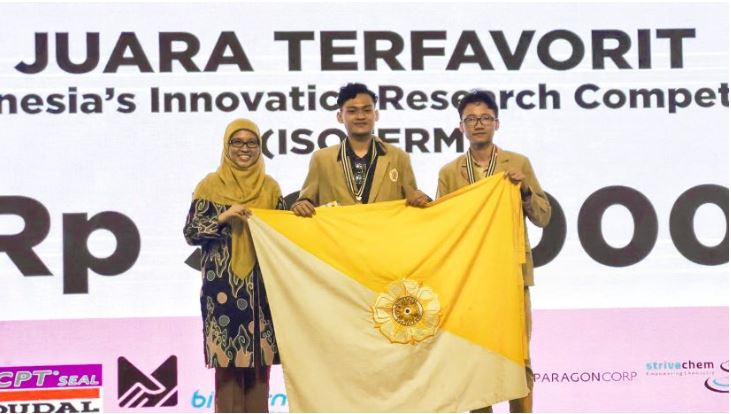
The GAMAWINGS team, a collaboration of Nuclear Engineering and Physics Engineering students from Universitas Gadjah Mada (UGM), won 2nd place and the favorite team title in Indonesia’s Innovative Research Competition (ISOTERM) 2024.
Presenting a scientific paper titled “GAMAWINGS: Photovoltaic Smart Drone System for Radiation Detection and Environmental Monitoring to Realize an Inclusive, Safe, and Sustainable Area,” the UGM student team showcased their ideas in this nationwide competition.
ISOTERM is a national scientific paper competition for undergraduate students across Indonesia, orchestrated by the Chemistry Student Association ‘AMISCA’ of Bandung Institute of Technology.
Themed “Chemical Entrepreneurship: Bridging Innovations for a Sustainable Future,” ISOTERM 2024 aimed to foster ideas, innovations, and solutions from Indonesian students towards building a sustainable future.
The competition encompassed five sub-themes: green innovation, bio-based chemistry, analytical control, nano-material, and sustainable drugs.
The stages of ISOTERM included abstract selection from Oct. 17 to Nov. 17, 2023, the first wave of full paper selection from Nov. 20 to Dec. 20, 2023, the second wave of full paper selection from Dec. 21, 2023, to Jan. 6, 2024, culminating in the final round on Jan. 27-28, 2024, on the Bandung Institute of Technology Ganesha Campus.
Comprising Jalalludin Mukhtafi, Marchelino Chrisrichy Cosmo Hutama (Nuclear Engineering 2021), and Panji Dewandaru (Physics Engineering 2021), under the mentorship of Dr. Nur Abdillah Siddiq, the team competed in ISOTERM under the sub-theme of analytical control.
Jalalludin Mukhtafi, serving as the team leader, elucidated that the GAMAWINGS innovation stemmed from a scenario involving radioactive waste discovered in Batan Indah Housing on Jan. 30-31, 2020, and the escalating radiation exposure from TENORM (Technologically Enhanced Naturally Occurring Radioactive Materials) attributed to mining operations and petrochemical industries.
He mentioned that in handling the Batan Indah case, some personnel wore complete personal protective equipment (PPE), including special clothing, while others did not.
“This is a serious concern because radioactive substances that come into contact with personnel without PPE can cause contamination,” he said on Thursday (Feb. 1).
“Excessive contamination of radioactive substances can lead to reactions and skin diseases such as hair loss and skin damage, disruption of normal functions (such as radiation pneumonitis), carcinogenesis effects, genetic effects, and even death.”
He further explained that exposure to TENORM radiation could have similar consequences. Therefore, a remote system and device capable of monitoring environmental radioactivity are needed.
GAMAWINGS, as its full name Gadjah Mada Radiation Monitoring and Inspection Wings suggests, is a minimum viable product (MVP) autonomous device capable of detecting environmental radioactivity with minimal contact with materials at commercial and mining sites in the form of a drone.
The drone, Mukhtafi detailed, will execute three missions: scouting, constructing a 3D contour map using LiDAR data; monitoring, counting radioactive areas via a GMC at low altitudes to generate a heatmap complementing the 3D map; and inspection, landing in hotspot areas to identify radionuclides using CZT with gamma spectroscopy.
“The Drone will navigate, store data, and land at the ground control station (GCS) integrated with wireless power transfer (WPT), powered by perovskite solar cell (PSC) solar panels renowned for their superior efficiency,” Mukhtafi elaborated.
Adding to the discussion, Marchelino Hutama emphasized the team’s business prospects as a platform as a service (PaaS) adopting a business-to-consumer (B2C) model, offering a monitoring website accessible to end-users, particularly in the commercial and mining sectors, to foster sustainable communities and health, safety, and environment (HSE).
“GAMAWINGS is equipped with CZT scintillation detectors and Geiger Müller Counter to monitor environmental radioactivity, ensuring high radiation exposure environments are under constant surveillance,” Hutama noted.
Panji Dewandaru further elucidated that the drone’s payload and components are designed to maintain flight stability, enabling optimal performance in scouting, monitoring, and identification functions.
Real-time data received by the drone will be transmitted to the center, processed, and displayed on the website for effective communication and public dissemination.
With their scientific paper, the GAMAWINGS team aims to provide tangible solutions to similar challenges and pioneer an efficient autonomous environmental radioactivity detection device system.
“We aspire that our work inspires and motivates our colleagues to continue their endeavors. Numerous national and international competitions await students; failure should not deter creativity. Let’s seize these opportunities to contribute extraordinary ideas for Indonesia’s bright future,” Dewandaru concluded.
Author: Agung Nugroho

